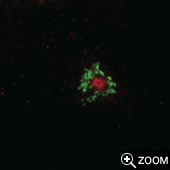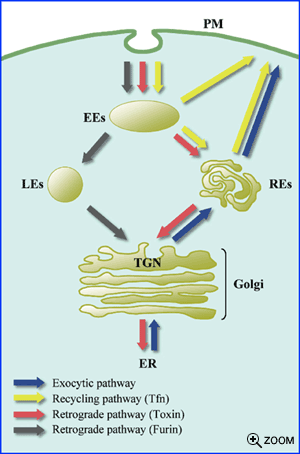|
|
| |
|
|
| |
| |


 |

The
Project Leader's Profile
Tomohiko
Taguchi (Ph.D.)
Visiting Associate
Professor, Osaka University Medical
School/ Graduate School of Medicine
In 1997, completed the doctoral course
at the Graduate School of Science,
University of Tokyo (Department of
Biophysics and Biochemistry), and obtained
his Ph.D. In 1997, appointed as Special
Postdoctoral Researcher at RIKEN (Institute
of Physical and Chemical Research).
In 1999-2004, engaged in membrane trafficking
research at Yale University School
of Medicine (1999-2001: JSPS Postdoctral
Fellowships for Research Abroad; 2001-2002:
Fellowship from Uehara Memorial Foundation;
2002-2004: JSPS Overseas Research Fellowship).
 |



The function and identity of recycling endosomes (REs) has been elusive for many years. That they represent a distinct population from early endosomes (EEs) is reasonably well established, as REs are reached by endocytic tracers such as transferrin (Tfn) with distinct kinetics and have a distinct Rab GTPase profile, being enriched, for example, in Rab11. REs are often, but not always, found in the perinuclear area, located very close to the Golgi complex, and are thought to comprise of a complex of vesicles and tubules with a less acidic pH than EEs.
We have recently found that REs play an indispensable role in the exocytic pathway (the Golgi complex to plasma membrane) and the retrograde traffic of cholera/Shiga toxin. REs could then be recognized as a sorting center with multifunction, since we know now that there are at least three major traffic pathways crossing over, such as recycling traffic represented by Tfn (EEs - REs - the plasma membrane), exocytic traffic (the Golgi complex - REs - the plasma membrane), and retrograde traffic represented by toxins (EEs - REs – the Golgi complex) and TGN38.
We are currently trying to identify residential REs proteins, either by biochemical means using specific ligands (colloidal Au/Fe) or by comprehensive screening of rab proteins, so that we can address how REs organize these complex traffic.

Fig.1 RE in COS-1 cell
|
 |
| Fig.2 Exocytic pathways on RE |


| 1) |
Mitra K, Ubarretxena-Belandia I, Taguchi T, Warren G, and Engelman DM. Modulation of the bilayer thickness of exocytic pathway membranes by membrane proteins rather that cholesterol. Proc. Natl. Acad. Sci. USA., 101, 4083-4088, 2004. |
| 2) |
Ang AL, Taguchi T, Francis S, Folsh H, Murrells LJ, Pypaert M, Warren G, and Mellman I. Recycling endosomes can serve as intermediates during transport from the Golgi to the plasma membrane of MDCK cells. J. Cell Biol., 167, 531-543, 2004. |
| 3) |
Taguchi T, Pypaert M, and Warren G. Biochemical sub-fractionation of the Mammalian Golgi apparatus. Traffic, 4, 344-352, 2003. |
| 4) |
Seemann J, Pypaert M, Taguchi T, Malsam J, and Warren G. Partitioning of the matrix fraction of the Golgi apparatus during mitosis in animal cells. Science, 295, 848-851, 2002. |
|
|
|
|
|
| PAGE TOP |
Copyright 2003 Osaka University. All Right Reserved.
Integrated functional analyses of disease-associated sugar chains and proteins, Osaka University

|
|
|
|
|